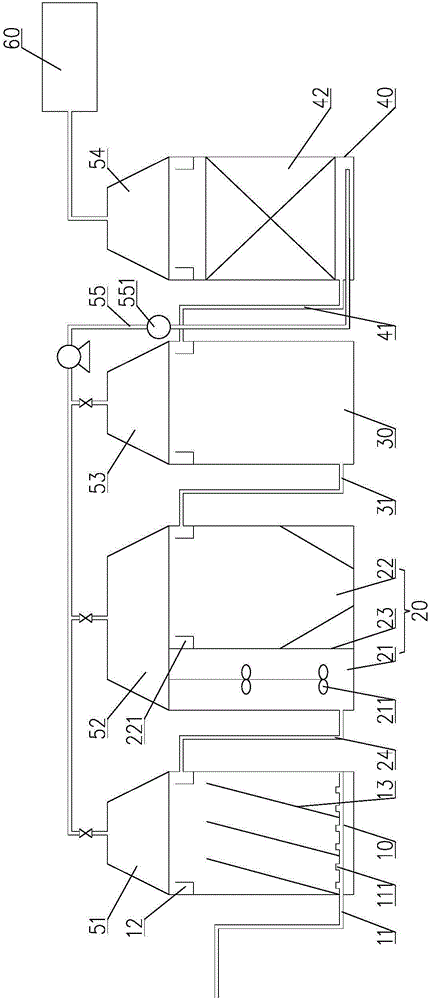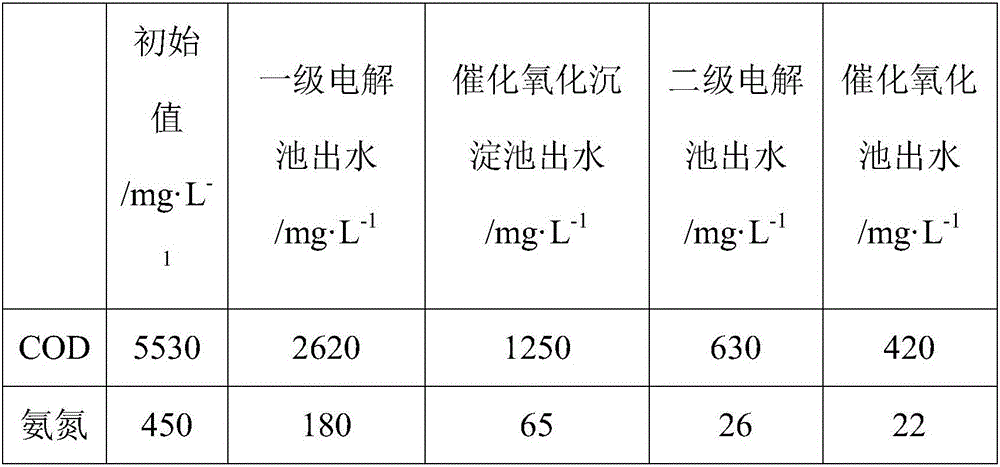Method and device for electrochemical treatment of medical and chemical wastewater
A technology for wastewater treatment and electrochemistry, applied in chemical instruments and methods, precipitation treatment, multi-stage water treatment, etc., can solve the problems of increased voltage required for electrolytic cells, reduced wastewater treatment efficiency, and refractory benzene degradation, etc., to achieve Improve the effect of wastewater treatment, low cost, and improve the effect of current utilization
- Summary
- Abstract
- Description
- Claims
- Application Information
AI Technical Summary
Problems solved by technology
Method used
Image
Examples
Embodiment 1
[0045] See figure 1 Shown: The device for electrochemically treating medical and chemical wastewater is used to treat medical and chemical wastewater. Specifically, the device includes: a primary electrolytic cell 10 , a catalytic reaction sedimentation cell 20 , a secondary electrolytic cell 30 and a catalytic reaction cell 40 .
[0046] The bottom of the primary electrolytic cell 10 is connected to a water inlet pipe 11 for feeding medical waste water, and the upper part of the primary electrolytic cell 10 is provided with a first overflow port 12 . That is, medical waste water enters the primary electrolytic cell 10 from bottom to top through the water inlet pipe 11 , and flows out through the first overflow port 12 after the treatment is completed.
[0047]The catalytic reaction sedimentation tank 20 is divided into a degassing tank 21 and a sedimentation tank 22 by a generally vertical partition 23 . The lower part of the degassing tank 21 is connected to the first over...
Embodiment 2
[0058] The method for electrochemically treating medical and chemical wastewater can be realized by means of the device for electrochemically treating medical and chemical wastewater described in Example 1. Specifically include the following steps:
[0059] (1) The medical waste water is sent to the primary electrolytic cell 10 through the water inlet pipe 11 for oxidation, the conductivity is adjusted to be above 1000 μs / cm by using NaCl, and the current density is 20-100 A / m 2 , the pH value is 4~6, the electrolysis time is 0.5~3h, and the medical and chemical wastewater contains Cl in the electrode plate and electrolysis 2 , ClO - Under the action of the strong oxidant of OH and OH, the macromolecular substances in the wastewater can be decomposed, and the wastewater for primary treatment can be obtained. For example, use NaCl to adjust the conductivity at 1000, 1200 or 1500μs / cm, and the current density at 20, 50, 80 or 100A / m 2 , the pH value is 4, 5 or 6, and the elec...
PUM
 Login to View More
Login to View More Abstract
Description
Claims
Application Information
 Login to View More
Login to View More - R&D
- Intellectual Property
- Life Sciences
- Materials
- Tech Scout
- Unparalleled Data Quality
- Higher Quality Content
- 60% Fewer Hallucinations
Browse by: Latest US Patents, China's latest patents, Technical Efficacy Thesaurus, Application Domain, Technology Topic, Popular Technical Reports.
© 2025 PatSnap. All rights reserved.Legal|Privacy policy|Modern Slavery Act Transparency Statement|Sitemap|About US| Contact US: help@patsnap.com


